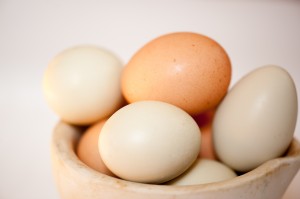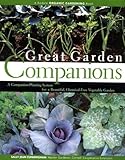Tuesday, February 18, 2014
Book Review: Great Garden Companions
Great Garden Companions: A Companion-Planting System for a Beautiful, Chemical-Free Vegetable Garden by Sally Jean Cunningham
I've been fascinated lately with the idea of permaculture, and one of the basic and easy to implement pieces of that idea is companion planting. If you've read Rosalind Creasy's Edible Landscaping, you know there's a lot that can be done to make gardens both more productive and more beautiful. Add a little "Carrots Love Tomatoes" - which lists which vegetables do well with which (according to various old wives' tales and anecdotes, not necessarily backed up with solid facts) - and you're really getting started. Then add in some Lasagne Gardening (building easy, fertile raised beds), a touch of Rodale's Encyclopedia of Organic Gardening (listing different vegetables and how to grow them, as well as identifying garden pests and how to deal with them), John Jeavon's How to Grow More Vegetables Than You Ever Thought Possible on Less Land Than You Can Imagine ("bio-intensive" gardening in wide rows rather than single-crop rows), and Good Bugs for Your Garden, and you're well on your way. Or you could just read this book, get the basic information you need, and actually have time to get outside and do it!
I was particularly impressed by the fact that this book is so practical - this is what she actually does in her own garden (not just theoretical ideas, or second-hand passed-down principles), and she details exactly what you can do to get the same results. She includes diagrams of her garden - how she pairs up plants in each bed (and why), how she works in crop rotation, and how you can adapt her plans to your own situation.
This book focuses heavily on attracting beneficial insects to your garden, which in the author's experience drastically reduces pest problems in her vegetables, as well as increasing pollination. One of her favorite ways of doing this is to include flowers and herbs that attract these beneficials (and which also look and/or taste wonderful!)
Another benefit of companion planting is that it simplifies weed control - with plants covering all of the bed, short plants mixed with tall ones, etc., it leaves little room for weeds. And since there is such a variety of plants, they each give and take different nutrients, making it a much more balanced system.
I can't wait until it warms up enough for me to put this book to work in my garden!
Note: I was not payed to review this book, I just really love it! But if you click on any of the links above and buy a book at amazon.com, I will receive a small commission from the sale. Thank you for your support!
Saturday, February 15, 2014
Brew Your Own Kombucha in 10 Easy Steps
I took a lot of convincing, but I'm now a true kombucha convert. My first experience was not a good one - a friend of mine let me try some of her homemade batch, but it was unflavored and apparently pretty strong, and I didn't like it at all. I don't like caffeinated tea generally (as opposed to herbal tea, which I love), and I'm sure that contributed to my dislike.
I put off trying it again for a long time (my sister-in-law, Mama Hen, has been trying to get me to give it a second chance for about a year now). My unwillingness was strengthened by the fact that you need to make it with white sugar (apparently natural sweeteners like honey or maple syrup won't work). I learned, however, that in the fermenting process the sugar is digested by the Symbiotic Colony Of Bacteria and Yeast (or SCOBY - basically the "starter", which looks kind of like a mushroom or jellyfish floating on the top of your tea. Kinda weird, but kinda cool, too, in a food-nerdy kind of way). So I started to consider trying it again.
 |
| My SCOBY |
But there was still the problem of the taste. Quick to defend her beloved beverage, Mama Hen showed me that kombucha can be easily flavored with whatever you like. While I was staying with her one weekend, I tried some of her ginger flavored kombucha, and I was converted. I liked it, and what's more, the kids liked it! I asked her how hard it was to make, and she immediately said, "It's easy! Let me show you! I'll even give you a SCOBY to take home with you!"
And so it began. When I got home, I found a message from Mama Hen saying she'd just tried making blueberry flavored kombucha, and that her family loved it - so that's the flavor I tried for my first batch (it helped that I had blueberries already on hand). The kids loved it; so much, in fact, that by the time I got out my camera, this was all that was left of the gallon I'd made:
Kombucha
1. Boil 4 cups of uncholrinated water
2. Steep 2 Tablespoons of green or black tea (cannot be a decaffeinated variety! And yes, it must be real tea, not an herbal infusion) for 5-7 minutes
3. Strain out tea into one gallon glass jar
4. Mix in one cup of white sugar
5. Top off jar with cold, unchlorinated water, leaving at least an inch of headspace
6. Make sure that the jar of sugar water isn't too hot, then gently pour in the SCOBY with its incubator liquid
7. Cover with a cloth or coffee filter, secured with a rubber band (especially in the summer - fruit flies LOVE this!) and place your jar in a dark place (like a cupboard) for 7-10 days (longer if your fermenting spot is cool, or if you want a bolder flavor. You can brew it up to 30 days. Check the flavor by inserting a straw under the SCOBY, capping with your finger, pulling out the straw, and then tasting)
8. Remove your SCOBY and 1-2 cups of tea as an incubator for your next batch (or just brew up another batch and put your SCOBY back to work!)
9. Add flavoring to your finished kombucha - my favorite is blueberry; just add 1/4 cup of blueberry juice to your gallon of kombucha. Other flavor ideas: cranberry, ginger, or anything else you think would be good! You can certainly pour your kombucha in to smaller jars and flavor each one differently. Feel free to experiment!
10. (Optional) You can do a second ferment, leaving your flavored jars in a dark place for another two or three days for extra probiotic goodness.
Enjoy!
Thursday, February 13, 2014
Egg-celent Article on the Price of Selling Eggs
I ran across this article this morning and thought it would be a good one to share here. If you're already selling eggs, or only dreaming of raising chickens one day, it's good to have a handle on the real cost of raising top-quality eggs in your back yard. Of course, for me, raising my own laying flock is more about boosting my kids' health and nutrition (you can't buy eggs as good as mine in any store!) than about economics, but it's still good information. I found his comments to be spot-on, with a few minor adjustments for local organic feed costs in my area.
Here's the blurb from the top of the article:
"Josh shares the facts and figures of raising pasture-raised, free-range, organic-fed hen eggs. It's math that can really help you understand your inputs and what you should be charging for that dozen of eggs you collect from your chickens."

Small Farm "Egg-onomics" from On Pasture
http://onpasture.com/2013/12/02/small-farm-egg-onomics/
Here's the blurb from the top of the article:
"Josh shares the facts and figures of raising pasture-raised, free-range, organic-fed hen eggs. It's math that can really help you understand your inputs and what you should be charging for that dozen of eggs you collect from your chickens."

Small Farm "Egg-onomics" from On Pasture
http://onpasture.com/2013/12/02/small-farm-egg-onomics/
Brownies ala My Husband
My husband is a genius.
"You know those awesome Maple Syrup Brownies you make? Why don't you put a layer of Healthy Fudge on top, like a frosting?"
Yup, he's a genius. Especially where chocolate is concerned.
"You know those awesome Maple Syrup Brownies you make? Why don't you put a layer of Healthy Fudge on top, like a frosting?"
Yup, he's a genius. Especially where chocolate is concerned.
Wednesday, February 5, 2014
Don't Skip the Nutribalancer!
I've been tempted to leave out the Nutribalancer from my home-mixed chicken feed, but I learned the hard way that it's not such a good idea. Our bag ran out mid-January, and it was a week before we could get more. In the meantime, my flock stopped laying altogether! Thankfully, a few days after we started mixing in the Nutribalancer again, they started right up again, and we're almost back to our normal egg totals. Lesson learned!
Subscribe to:
Posts (Atom)


